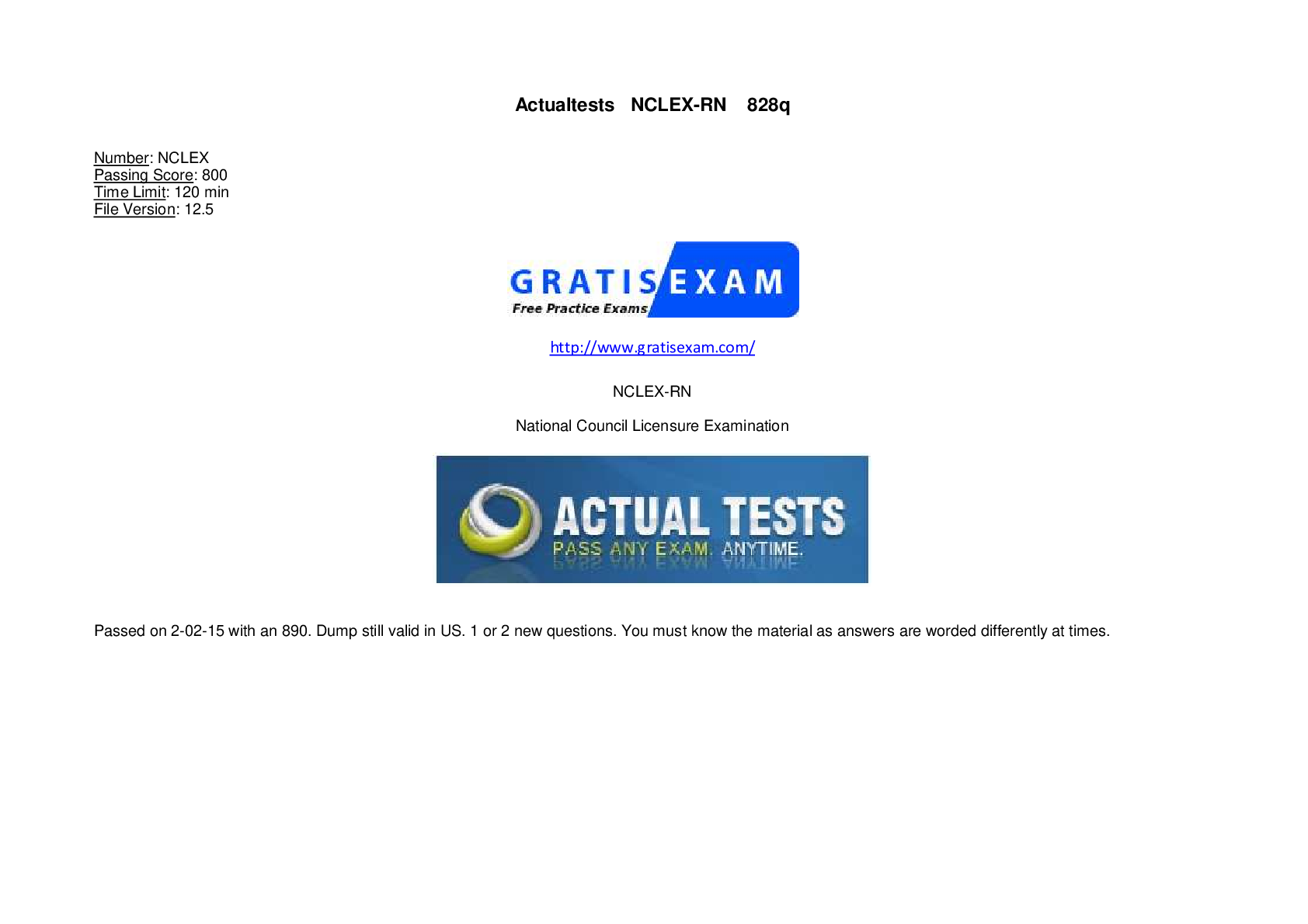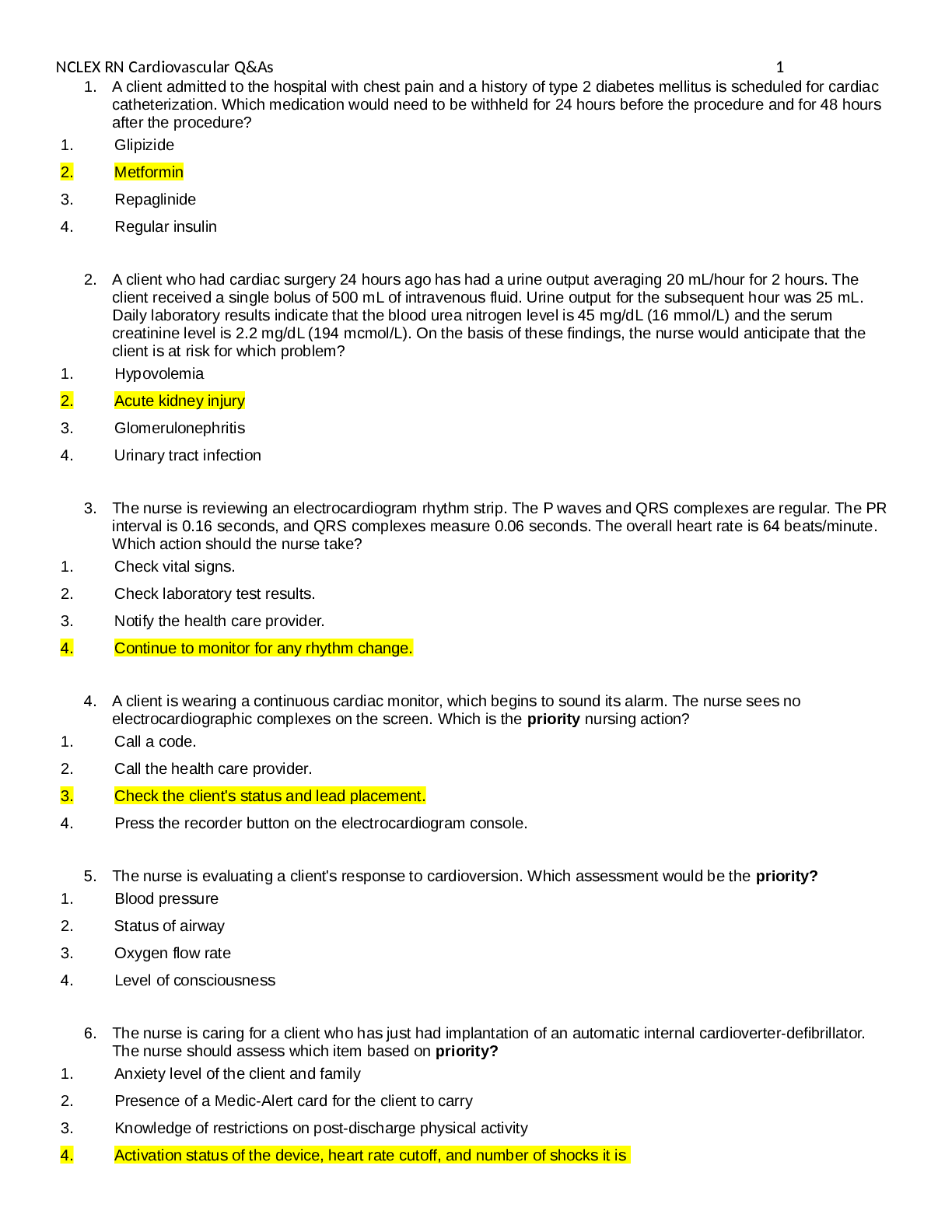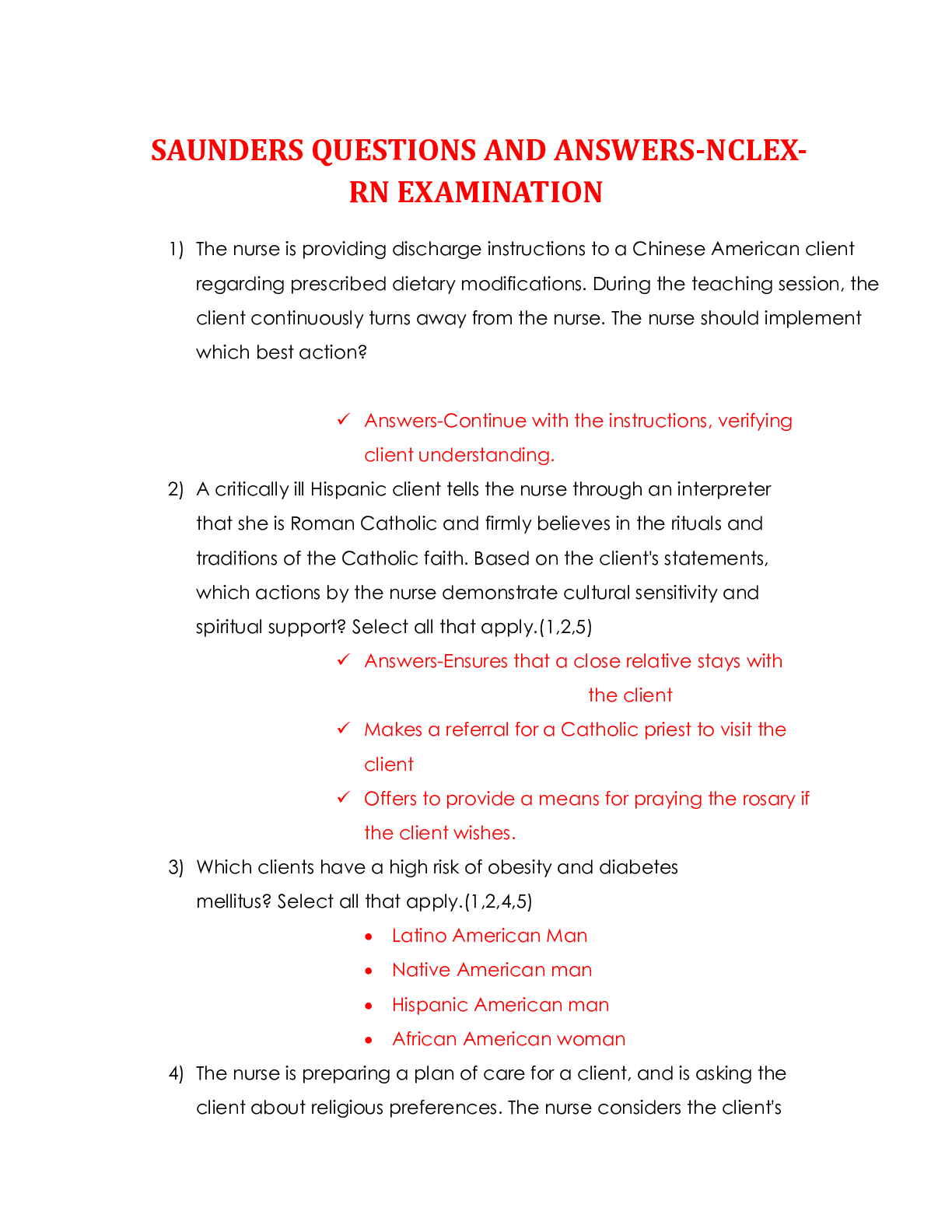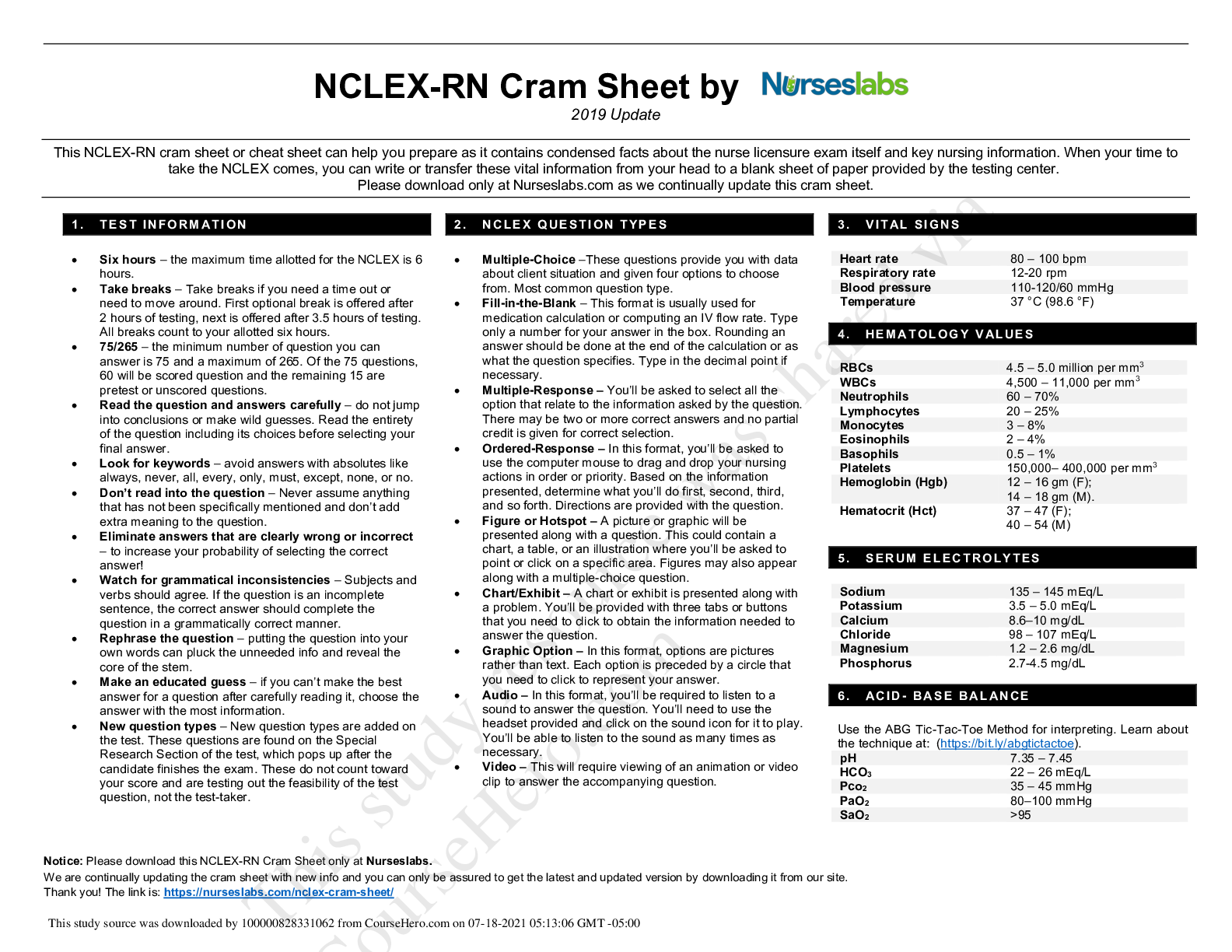NURSING 101 NCLEX-RN - Practise Questions, Answers Provided
Document Content and Description Below
A 25-year-old client believes she may be pregnant with her first child. She schedules an obstetric examination with the nurse practitioner to determine the status of her possible pregnancy. Her last ... menstrual period began May 20, and her estimated date of confinement using Nägele's rule is: A. March 27 B. February 1 C. February 27 D. January 3 Correct Answer: C Section: (none) Explanation Explanation/Reference: Explanation: (A)March 27 is a miscalculation. (B) February 1 is a miscalculation. (C) February 27 is the correct answer. To calculate the estimated date of confinement using Nagele's rule, subtract 3 months from the date that the last menstrual cycle began and then add 7 days to the result. (D) January 3 is a miscalculation. QUESTION 2 The nurse practitioner determines that a client is approximately 9 weeks' gestation. During the visit, the practitioner informs the client about symptoms of physical changes that she will experience during her first trimester, such as: A. Nausea and vomiting B. Quickening C. A 68 lb weight gain D. Abdominal enlargement Correct Answer: A Section: (none) Explanation Explanation/Reference: Explanation: (A) Nausea and vomiting are experienced by almost half of all pregnant women during the first 3 months of pregnancy as a result of elevated human chorionic gonadotropin levels and changed carbohydrate metabolism. (B) Quickening is the mother's perception of fetal movement and generally does not occur until 1820 weeks after the last menstrual period in primigravidas, but it may occur as early as 16 weeks in multigravidas. (C) During the first trimester there should be only a modest weight gain of 24 lb. It is not uncommon for women to lose weight during the first trimester owing to nausea and/or vomiting. (D) Physical changes are not apparent until the second trimester, when the uterus rises out of the pelvis. QUESTION 3 A 38-year-old pregnant woman visits her nurse practitioner for her regular prenatal checkup. She is 30 weeks' gestation. The nurse should be alert to which condition related to her age? A. Iron-deficiency anemia B. Sexually transmitted disease (STD) C. Intrauterine growth retardation D. Pregnancy-induced hypertension (PIH) Correct Answer: D Section: (none) Explanation Explanation/Reference: Explanation: (A) Iron-deficiency anemia can occur throughout pregnancy and is not age related. (B) STDs can occur prior to or during pregnancy and are not age related. (C) Intrauterine growth retardation is an abnormal process where fetal development and maturation are delayed. It is not age related. (D) Physical risks for the pregnant client older than 35 include increased risk for PIH, cesarean delivery, fetal and neonatal mortality, and trisomy. QUESTION 4 A client returns for her 6-month prenatal checkup and has gained 10 lb in 2 months. The results of her physical examination are normal. How does the nurse interpret the effectiveness of the instruction about diet and weight control? A. She is compliant with her diet as previously taught. B. She needs further instruction and reinforcement. C. She needs to increase her caloric intake. D. She needs to be placed on a restrictive diet immediately. Correct Answer: B Section: (none) Explanation Explanation/Reference: Explanation: (A) She is probably not compliant with her diet and exercise program. Recommended weight gain during second and third trimesters is approximately 12 lb. (B) Because of her excessive weight gain of 10 lb in 2 months, she needs re-evaluation of her eating habits and reinforcement of proper dietary habits for pregnancy. A 2200-calorie diet is recommended for most pregnant women with a weight gain of 2730 lb over the 9-month period. With rapid and excessive weightgain, PIH should also be suspected. (C) She does not need to increase her caloric intake, but she does need to re-evaluate dietary habits. Ten pounds in 2 months is excessive weight gain during pregnancy, and health teaching is warranted. (D) Restrictive dieting is not recommended during pregnancy. QUESTION 5 Diabetes during pregnancy requires tight metabolic control of glucose levels to prevent perinatal mortality. When evaluating the pregnant client, the nurse knows the recommended serum glucose range during pregnancy is: A. 70 mg/dL and 120 mg/dL B. 100 mg/dL and 200 mg/dL C. 40 mg/dL and 130 mg/dL D. 90 mg/dL and 200 mg/dL Correct Answer: A Section: (none) Explanation Explanation/Reference: Explanation: (A) The recommended range is 70120 mg/dL to reduce the risk of perinatal mortality. (B, C, D) These levels are not recommended. The higher the blood glucose, the worse the prognosis for the fetus. Hypoglycemia can also have detrimental effects on the fetus. QUESTION 6 When assessing fetal heart rate status during labor, the monitor displays late decelerations with tachycardia and decreasing variability. What action should the nurse take? A. Continue monitoring because this is a normal occurrence. B. Turn client on right side. C. Decrease IV fluids. D. Report to physician or midwife. Correct Answer: D Section: (none) Explanation Explanation/Reference: Explanation: (A) This is not a normal occurrence. Late decelerations need prompt intervention for immediate infant recovery. (B) To increase O2 perfusion to the unborn infant, the mother should be placed on her left side. (C) IV fluids should be increased, not decreased. (D) Immediate action is warranted, such as reporting findings, turning mother on left side, administering O2, discontinuing oxytocin (Pitocin), assessing maternal blood pressure and the labor process, preparing for immediate cesarean delivery, and explaining plan of action to client. QUESTION 7 The predominant purpose of the first Apgar scoring of a newborn is to: A. Determine gross abnormal motor function B. Obtain a baseline for comparison with the infant's future adaptation to the environment C. Evaluate the infant's vital functions D. Determine the extent of congenital malformations Correct Answer: C Section: (none) Explanation Explanation/Reference: Explanation: (A) Apgar scores are not related to the infant's care, but to the infant's physical condition. (B) Apgar scores assess the current physical condition of the infant and are not related to future environmental adaptation. (C) The purpose of the Apgar system is to evaluate the physical condition of the newborn at birth and to determine if there is an immediate need for resuscitation. (D) Congenital malformations are not one of the areas assessed with Apgar scores. QUESTION 8 A pregnant woman at 36 weeks' gestation is followed for PIH and develops proteinuria. To increase protein in her diet, which of the following foods will provide the greatest amount of protein when added to her intake of 100 mL of milk? A. Fifty milliliters light cream and 2 tbsp corn syrup B. Thirty grams powdered skim milk and 1 egg C. One small scoop (90 g) vanilla ice cream and 1 tbsp chocolate syrup D. One package vitamin-fortified gelatin drink Correct Answer: B Section: (none) Explanation Explanation/Reference: Explanation: (A) This choice would provide more unwanted fat and sugar than protein. (B) Skim milk would add protein. Eggs are good sources of protein while low in fat and calories. (C) The benefit of protein from ice cream would be outweighed by the fat content. Chocolate syrup has caffeine, which is contraindicated or limited in pregnancy. (D) Although most animal proteins are higher in protein than plant proteins, gelatin is not. It loses protein during the processing for food consumption. QUESTION 9 Which of the following findings would be abnormal in a postpartal woman? A. Chills shortly after delivery B. Pulse rate of 60 bpm in morning on first postdelivery day C. Urinary output of 3000 mL on the second day after delivery D. An oral temperature of 101F (38.3C) on the third day after delivery Correct Answer: D Section: (none) Explanation Explanation/Reference: Explanation: (A) Frequently the mother experiences a shaking chill immediately after delivery, which is related to a nervous response or to vasomotor changes. If not followed by a fever, it is clinically innocuous. (B) The pulse rate during the immediate postpartal period may be low but presents no cause for alarm. The body attempts to adapt to the decreased pressures intra-abdominally as well as from the reduction of blood flow to the vascular bed. (C) Urinary output increases during the early postpartal period (1224 hours) owing to diuresis. The kidneys must eliminate an estimated 20003000 mL of extracellular fluid associated with a normal pregnancy. (D) A temperature of 100.4F (38C) may occur after delivery as a result of exertion and dehydration of labor. However, any temperature greater than 100.4F needs further investigation to identify any infectious process. QUESTION 10 What is the most effective method to identify early breast cancer lumps? A. Mammograms every 3 years B. Yearly checkups performed by physician C. Ultrasounds every 3 years D. Monthly breast self-examination Correct Answer: D Section: (none) Explanation Explanation/Reference: Explanation: (A) Mammograms are less effective than breast self-examination for the diagnosis of abnormalities in younger women, who have denser breast tissue. They are more effective forwomen older than 40. (B) Up to 15% of early-stage breast cancers are detected by physical examination; however, 95% are detected by women doing breast self-examination. (C) Ultrasound is used primarily to determine the location of cysts and to distinguish cysts from solid masses. (D) Monthly breast self-examination has been shown to be the most effective method for early detection of breast cancer. Approximately 95% of lumps are detected by women themselves. QUESTION 11 Which of the following risk factors associated with breast cancer would a nurse consider most significant in a client's history? A. Menarche after age 13 B. Nulliparity C. Maternal family history of breast cancer D. Early menopause Correct Answer: C Section: (none) Explanation Explanation/Reference: Explanation: (A) Women who begin menarche late (after 13 years old) have a lower risk of developing breast cancer than women who have begun earlier. Average age for menarche is 12.5 years. (B) Women who have never been pregnant have an increased risk for breast cancer, but a positive family history poses an even greater risk. (C) A positive family history puts a woman at an increased risk of developing breast cancer. It is recommended that mammography screening begin 5 years before the age at which an immediate female relative was diagnosed with breast cancer. (D) Early menopause decreases the risk of developing breast cancer. QUESTION 12 The nurse should know that according to current thinking, the most important prognostic factor for a client with breast cancer is: A. Tumor size B. Axillary node status C. Client's previous history of disease D. Client's level of estrogen-progesterone receptor assays Correct Answer: B Section: (none) Explanation Explanation/Reference: Explanation: (A) Although tumor size is a factor in classification of cancer growth, it is not an indicator of lymph node spread. (B) Axillary node status is the most important indicator for predicting how far the cancer has spread. If the lymph nodes are positive for cancer cells, the prognosis is poorer. (C) The client's previous history of cancer puts her at an increased risk for breast cancer recurrence, especially if the cancer occurred in the other breast. It does not predict prognosis, however. (D) The estrogen-progesterone assay test is used to identify present tumors being fedfrom an estrogen site within the body. Some breast cancers grow rapidly as long as there is an estrogen supply such as from the ovaries. The estrogen-progesterone assay test does not indicate the prognosis. QUESTION 13 A 30-year-old male client is admitted to the psychiatric unit with a diagnosis of bipolar disorder. For the last 2 months, his family describes him as being "on the move," sleeping 34 hours nightly, spending lots of money, and losing approximately 10 lb. During the initial assessment with the client, the nurse would expect him to exhibit which of the following? A. Short, polite responses to interview questions B. Introspection related to his present situation C. Exaggerated self-importance D. Feelings of helplessness and hopelessness Correct Answer: C Section: (none) Explanation Explanation/Reference: Explanation: (A) During the manic phase of bipolar disorder, clients have short attention spans and may be abusive toward authority figures. (B) Introspection requires focusing and concentration; clients with mania experience flight of ideas, which prevents concentration. (C) Grandiosity and an inflated sense of self-worth are characteristic of this disorder. (D) Feelings of helplessness and hopelessness are symptoms of the depressive stage of bipolar disorder. QUESTION 14 A client with bipolar disorder taking lithium tells the nurse that he has ringing in his ears, blurred vision, and diarrhea. The nurse notices a slight tremor in his left hand and a slurring pattern to his speech. Which of the following actions by the nurse is appropriate? A. Administer a stat dose of lithium as necessary. B. Recognize this as an expected response to lithium. C. Request an order for a stat blood lithium level. D. Give an oral dose of lithium antidote. Correct Answer: C Section: (none) Explanation Explanation/Reference: Explanation: (A) These symptoms are indicative of lithium toxicity. A stat dose of lithium could be fatal. (B) These are toxic effects of lithium therapy. (C) The client is exhibiting symptoms of lithium toxicity, which may be validated by lab studies. (D) There is no known lithium antidote. QUESTION 15 Which of the following activities would be most appropriate during occupational therapy for a client with bipolar disorder? A. Playing cards with other clients B. Working crossword puzzles C. Playing tennis with a staff member D. Sewing beads on a leather belt Correct Answer: C Section: (none) Explanation Explanation/Reference: Explanation: (A) This activity is too competitive, and the manic client might become abusive toward the other clients. (B) During mania, the client's attention span is too short to accomplish this task. (C) This activity uses gross motor skills, eases tension, and expands excess energy. A staff member is better equipped to interact therapeutically with clients. (D) This activity requires the use of fine motor skills and is very tedious. QUESTION 16 Three weeks following discharge, a male client is readmitted to the psychiatric unit for depression. His wife stated that he had threatened to kill himself with a handgun. As the nurse admits him to the unit, he says, "I wish I were dead because I am worthless to everyone; I guess I am just no good." Which response by the nurse is most appropriate at this time? A. "I don't think you are worthless. I'm glad to see you, and we will help you." B. "Don't you think this is a sign of your illness?" C. "I know with your wife and new baby that you do have a lot to live for." D. "You've been feeling sad and alone for some time now?" Correct Answer: D Section: (none) Explanation Explanation/Reference: Explanation: (A) This response does not acknowledge the client's feelings. (B) This is a closed question and does not encourage communication. (C) This response negates the client's feelings and does not require a response from the client. (D) This acknowledges the client's implied thoughts and feelings and encourages a response. QUESTION 17 Which of the following statements relevant to a suicidal client is correct? A. The more specific a client's plan, the more likely he or she is to attempt suicide. B. A client who is unsuccessful at a first suicide attempt is not likely to make future attempts. C. A client who threatens suicide is just seeking attention and is not likely to attempt suicide. D. Nurses who care for a client who has attempted suicide should not make any reference to the word "suicide" in order to protect the client's ego. Correct Answer: A Section: (none) Explanation Explanation/Reference: Explanation: (A) This is a high-risk factor for potential suicide. (B) A previous suicide attempt is a definite risk factor for subsequent attempts. (C) Every threat of suicide should be taken seriously. (D) The client should be asked directly about his or her intent to do bodily harm. The client is never hurt by direct, respectful questions. QUESTION 18 The day following his admission, the nurse sits down by a male client on the sofa in the dayroom. He was admitted for depression and thoughts of suicide. He looks at the nurse and says, "My life is so bad no one can do anything to help me." The most helpful initial response by the nurse would be: A. "It concerns me that you feel so badly when you have so many positive things in your life." B. "It will take a few weeks for you to feel better, so you need to be patient." C. "You are telling me that you are feeling hopeless at this point?" D. "Let's play cards with some of the other clients to get your mind off your problems for now." Correct Answer: C Section: (none) Explanation Explanation/Reference: Explanation: (A) This response does not acknowledge the client's feelings and may increase his feelings of guilt. (B) This response denotes false reassurance. (C) This response acknowledges the client's feelings and invites a response. (D) This response changes the subject and does not allow the client to talk about his feelings. QUESTION 19 A long-term goal for the nurse in planning care for a depressed, suicidal client would be to: A. Provide him with a safe and structured environment. B. Assist him to develop more effective coping mechanisms. C. Have him sign a "no-suicide" contract. D. Isolate him from stressful situations that may precipitate a depressive episode. Correct Answer: B Section: (none) Explanation Explanation/Reference: Explanation: (A) This statement represents a short-term goal. (B) Long-term therapy should be directed toward assisting the client to cope effectively with stress. (C) Suicide contracts represent short- term interventions. (D) This statement represents an unrealistic goal. Stressful situations cannot be avoided in reality. QUESTION 20 After 3 weeks of treatment, a severely depressed client suddenly begins to feel better and starts interacting appropriately with other clients and staff. The nurse knows that this client has an increased risk for: A. Suicide B. Exacerbation of depressive symptoms C. Violence toward others D. Psychotic behavior Correct Answer: A Section: (none) Explanation Explanation/Reference: Explanation: (A) When the severely depressed client suddenly begins to feel better, it often indicates that the client has made the decision to kill himself or herself and has developed a plan to do so. (B) Improvement in behavior is not indicative of an exacerbation of depressive symptoms. (C) Thedepressed client has a tendency for self-violence, not violence toward others. (D) Depressive behavior is not always accompanied by psychotic behavior. QUESTION 21 Nursing care for the substance abuse client experiencing alcohol withdrawal delirium includes: A. Maintaining seizure precautions B. Restricting fluid intake C. Increasing sensory stimuli D. Applying ankle and wrist restraints Correct Answer: A Section: (none) Explanation Explanation/Reference: Explanation: (A) These clients are at high risk for seizures during the 1st week after cessation of alcohol intake. (B) Fluid intake should be increased to prevent dehydration. (C) Environmental stimuli should be decreased to prevent precipitation of seizures. (D) Application of restraints may cause the client to increase his or her physical activity and may eventually lead to exhaustion. QUESTION 22 A psychotic client who believes that he is God and rules all the universe is experiencing which type of delusion? A. Somatic B. Grandiose C. Persecutory D. Nihilistic Correct Answer: B Section: (none) Explanation Explanation/Reference: Explanation: (A) These delusions are related to the belief that an individual has an incurable illness. (B) These delusions are related to feelings of self-importance and uniqueness. (C) These delusions are related to feelings of being conspired against. (D) These delusions are related to denial of self- existence. QUESTION 23 A client confides to the nurse that he tasted poison in his evening meal. This would be an example of what type of hallucination? A. Auditory B. Gustatory C. Olfactory D. Visceral Correct Answer: B Section: (none) Explanation Explanation/Reference: Explanation: (A) Auditory hallucinations involve sensory perceptions of hearing. (B) Gustatory hallucinations involve sensory perceptions of taste. (C) Olfactory hallucinations involve sensory perceptions of smell. (D) Visceral hallucinations involve sensory perceptions of sensation. QUESTION 24 A schizophrenic client has made sexual overtures toward her physician on numerous occasions. During lunch, the client tells the nurse, "My doctor is in love with me and wants to marry me." This client is using which of the following defense mechanisms? A. Displacement B. Projection C. Reaction formation D. Suppression Correct Answer: B Section: (none) Explanation Explanation/Reference: Explanation: (A) Displacement involves transferring feelings to a more acceptable object. (B) Projection involves attributing one's thoughts or feelings to another person. (C) Reaction formation involves transforming an unacceptable impulse into the opposite behavior. (D) Suppression involves the intentional exclusion of unpleasant thoughts or experiences. QUESTION 25 Hypoxia is the primary problem related to near-drowning victims. The first organ that sustains irreversible damage after submersion in water is the: A. Kidney (urinary system) B. Brain (nervous system) C. Heart (circulatory system) D. Lungs (respiratory system) Correct Answer: B Section: (none) Explanation Explanation/Reference: Explanation: (A) The kidney can survive after 30 minutes of water submersion. (B) The cerebral neurons sustain irreversible damage after 46 minutes of water submersion. (C) The heart can survive up to 30 minutes of water submersion. (D) The lungs can survive up to 30 minutes of water submersion. QUESTION 26 One of the most dramatic and serious complications associated with bacterial meningitis is Waterhouse- Friderichsen syndrome, which is: A. Peripheral circulatory collapse B. Syndrome of inappropriate antiduretic hormone C. Cerebral edema resulting in hydrocephalus D. Auditory nerve damage resulting in permanent hearing loss Correct Answer: A Section: (none) Explanation Explanation/Reference: Explanation: (A) Waterhouse-Friderichsen syndrome is peripheral circulatory collapse, which may result in extensive and diffuse intravascular coagulation and thrombocytopenia resulting in death. (B) Syndrome of inappropriate antidiuretic hormone is a complication of meningitis, but it is not Waterhouse-Friderichsen syndrome. (C) Cerebral edema resulting in hydrocephalus is a complication of meningitis, but it is not Waterhouse-Friderichsen syndrome. (D) Auditory nerve damage resulting in permanent hearing loss is a complication of meningitis, but it is not Waterhouse- Friderichsen syndrome. [Show More]
Last updated: 1 year ago
Preview 1 out of 424 pages

Reviews( 0 )
Recommended For You
*NURSING> NCLEX-RN > Actual tests NCLEX-RN Compilation. (All)

Actual tests NCLEX-RN Compilation.
NCLEX-RN QUESTION 1 A 25-year-old client believes she may be pregnant with her first child. She schedules an obstetric examination with the nurse practitioner to determine the status of her possibl...
By Cheryshev , Uploaded: Sep 12, 2021
$30
*NURSING> NCLEX-RN > TEST BANK NCLEX QUESTIONS AND ANSWERS ALL UPDATED (All)

TEST BANK NCLEX QUESTIONS AND ANSWERS ALL UPDATED
ST BANK NCLEX QUESTIONS AND ANSWERS ALL UPDATED WELL 2021 QUESTIONS 1-15 Ref # 4366 The nurse receives a client from the post anesthesia care unit following a left femoral-popliteal bypass gr aft proc...
By Expert , Uploaded: Mar 14, 2021
$12
*NURSING> NCLEX-RN > NCLEX RN Cardiovascular 150 Q&A. The most commonly tested exam questions. (All)

NCLEX RN Cardiovascular 150 Q&A. The most commonly tested exam questions.
NCLEX RN Cardiovascular 150 Q&As 1. A client admitted to the hospital with chest pain and a history of type 2 diabetes mellitus is scheduled for cardiac catheterization. Which medication would ne...
By QuizMaster , Uploaded: Aug 20, 2020
$10
*NURSING> NCLEX-RN > TEST BANK NCLEX QUESTIONS AND ANSWERS (All)

TEST BANK NCLEX QUESTIONS AND ANSWERS
TEST BANK NCLEX QUESTIONS AND ANSWERS ALL UPDATED WELL 2021 QUESTIONS 1-15 Ref # 4366 The nurse receives a client from the post anesthesia care unit following a left femoral-popliteal bypass gr...
By klaus , Uploaded: Jan 25, 2021
$12
*NURSING> NCLEX-RN > ATI NCLEX RN Comprehensive Predictor 2019 Form A. ATI NCLEX Predictor. Contains 180 Q&A for nursing school personnel and students to Guarantee success on the NCLEX. (All)

ATI NCLEX RN Comprehensive Predictor 2019 Form A. ATI NCLEX Predictor. Contains 180 Q&A for nursing school personnel and students to Guarantee success on the NCLEX.
RN Comprehensive Predictor 2019 Form A 1. A nurse in a pediatric unit is preparing to insert an IV catheter for 7-year-old. Which of the following actions should the nurse take? A. (Unable to re...
By QuizMaster , Uploaded: Aug 16, 2020
$9
*NURSING> NCLEX-RN > SAUNDERS NCLEXRN EXAMINATION REVISON CONTENT. QUESTIONS AND ANSWERS (All)

SAUNDERS NCLEXRN EXAMINATION REVISON CONTENT. QUESTIONS AND ANSWERS
SAUNDERS QUESTIONS AND ANSWERS-NCLEX-RN EXAMINATION 1) The nurse is providing discharge instructions to a Chinese American client regarding prescribed dietary modifications. During th...
By QuizMaster , Uploaded: Aug 05, 2020
$9
*NURSING> NCLEX-RN > NCLEX RN & CGFNS Gastrointestinal Disorders Q&A. 200 Most Commonly tested Questions from Week 1 to 13- NC III (All)

NCLEX RN & CGFNS Gastrointestinal Disorders Q&A. 200 Most Commonly tested Questions from Week 1 to 13- NC III
NCLEX-RN & CGFNS Practice Question » Gastrointestinal Disorders Questions in Power points from Week 1 to 13- NC III Adequate nutrition is required for healing after treatment for recurrent aphtho...
By SuperSolutions© , Uploaded: Nov 28, 2020
$12
*NURSING> NCLEX-RN > NCLEX-RN Cram Sheet: This NCLEX-RN cram sheet or cheat sheet can help you prepare as it contains condensed facts about the nurse licensure exam itself and key nursing information: (All)

NCLEX-RN Cram Sheet: This NCLEX-RN cram sheet or cheat sheet can help you prepare as it contains condensed facts about the nurse licensure exam itself and key nursing information:
RBCs 4.5 – 5.0 million per mm3 NCLEX-RN Cram Sheet by 2020 Update This NCLEX-RN cram sheet or cheat sheet can help you prepare as it contains condensed facts about the nurse licensure exam itself and...
By Tutor Frankline , Uploaded: Jul 18, 2021
$9.5
*NURSING> NCLEX-RN > NCLEX RN ACTUAL EXAM TEST BANK OF REAL QUESTIONS & ANSWERS NCLEX 2023/2024 (All)

NCLEX RN ACTUAL EXAM TEST BANK OF REAL QUESTIONS & ANSWERS NCLEX 2023/2024
NCLEX RN ACTUAL EXAM TEST BANK OF REAL QUESTIONS & ANSWERS NCLEX 2023/2024
By GradesProff , Uploaded: Jul 19, 2023
$16
*NURSING> NCLEX-RN > NCLEX-RN EXAM QUESTIONS AND ANSWERS (LATEST VERSION) (All)
NCLEX-RN EXAM QUESTIONS AND ANSWERS (LATEST VERSION)
2022/2023 NCLEX-RN EXAM QUESTIONS AND ANSWERS (LATEST VERSION)/////////////2022/2023 NCLEX-RN EXAM QUESTIONS AND ANSWERS (LATEST VERSION)/////////2022/2023 NCLEX-RN EXAM QUESTIONS AND ANSWERS (LATEST...
By Rixx Dennis , Uploaded: Jun 02, 2022
$28
Document information
Connected school, study & course
About the document
Uploaded On
Mar 23, 2021
Number of pages
424
Written in
Additional information
This document has been written for:
Uploaded
Mar 23, 2021
Downloads
0
Views
68






